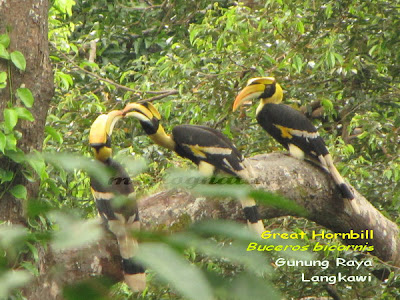Khazanah in Islam means "Treasure".
Langkawi's greatest khazanah will be her geological monuments and alongside with her richness of flora and fauna. As for the fauna, I will zoom into the bird life here. The island boasts herself of having more than two hundred species of birds inclusive the migratory ones. I dare say that one of Langkawi's khazanah will be the Great Hornbills (Buceros bicornis).
Great Hornbills can also be found on Peninsula Malaysia and what is so "khazanah" about them? My argument will be, to get a good and near glimpse of them on Peninsula Malaysia is not as easy as on Langkawi. On Peninsula Malaysia, you probably need to travel a fair bit to see Great Hornbills. And possibly, you will consider yourself lucky if you manage to spot a Great Hornbill flies into the forest or perch on a tree from a far distance.
The road built on Gunung Raya has provided an easy access for all to enjoy watching these amazing birds that form monogamous pairs. Easy accessibility to the top of this hill encouraged eco-tourism activities such as bird watching or simply by driving or walking up on the road to admire the wonders of her rainforest. Therefore, the "khazanah" will be $$$ from tourists for coming to Langkawi to see the Great Hornbills.
File picture
Easy access on this hill has invited one of the dangers to Langkawi's khazanah. What will that be?
I took my friend, who is also a tourist, up on Gunung Raya to spot for the Great Hornbills yesterday morning. We spent quite a long time looking for them until we gave up and decided to head down. On our descend from the hill, we were fortunate to spot a pair perched on a huge canopy tree. We were very excited to see them finally!
Then came along a pakcik (our local term for male elder) on his motorbike. I recognised this pakcik because he frequents up Gunung Raya. We chatted for awhile and I took the opportunity to ask him about the poor sightings of Great Hornbills on this hill lately. His shocking story came to us.
About two weeks ago, he witnessed some locals shot down three male Great Hornbills and slaughtered them. The pakcik called the Perhilitan (Wildlife Department) but there were no one to pick up his call. It was probably lunch time, according to the pakcik. I gave him the mobile numbers of Perhilitan rangers and so he can contact them directly should such incident happens again.
The poachers must have closely monitored the activities on the hill and have timed their modus operandi perfectly without being caught. The hornbills that were shot down usually ended up in the cooking pot and I am not sure if the meat possessed any medicinal values.
Poaching of wildlife is one of the greatest threat not only to Langkawi's biodiversity and as well as to the eco-tourism sector. Eco-tourism happens to contribute the highest revenue to Langkawi, largely due to the duty free and UNESCO Geopark status.
My tourist friend was shocked and saddened with such news.
Reference:







Just can't believe there are poachers!!! Arhhhh! *__*
ReplyDeleteSuzanna
sucks!! Hornbills also want!!
ReplyDeleteSteph
hmm, wish there is a law for shoot poachers on sight.. then question later
ReplyDeletewan yeng
To those commented,
ReplyDeleteYes, I cannot believe this too.. :(